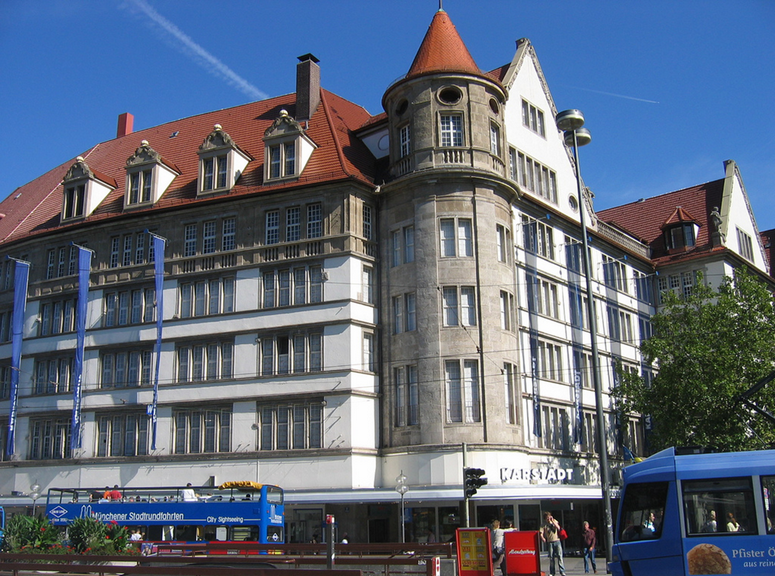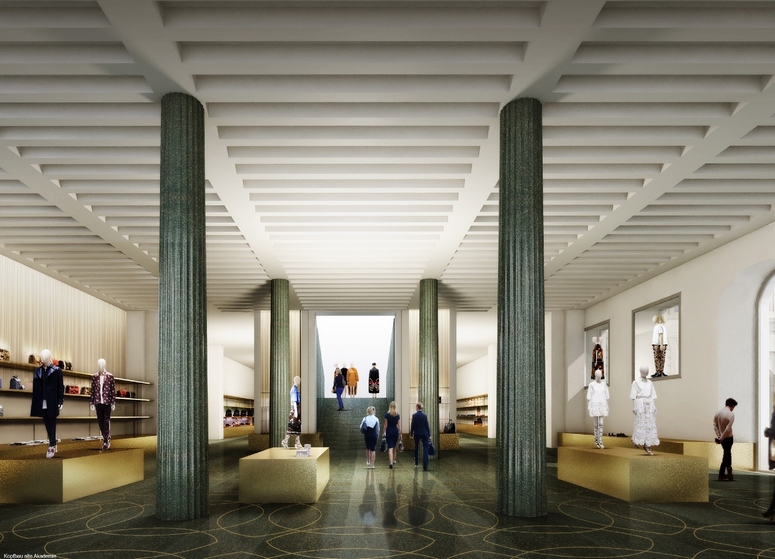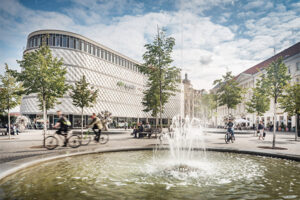SIGNA Real Estate‘s investment pipeline is full for the next few years: With a project development budget of more than 4 billion Euros, the company is one of the largest private real estate developers in its core central European markets Austria, Germany and Northern Italy.
In Munich SIGNA will invest about 1 billion Euros in two inner-city development projects: the „Munich Karstadt Station“ project and the Alte Akademie.
New investment Munich Karstadt Station: The link between the Hauptbahnhof and the Munich Stachus
In a central location in Munich between the Central Train Station and Stachus, SIGNA has entered into a joint venture with its partner RFR, participating in the work on the department store ensemble known as the „Munich Karstadt Station“.
The six-storey old building was constructed in 1904/1905, the new building followed in 1972 and was opened on the occasion of the Summer Olympics in Munich.

The existing building, located on Schützenstrasse and Prielmayerstrasse, consists of an old part and a newly constructed part of the building, which are connected on the lower floors, and which feature 137 meter continuous store fronts in the pedestrian zone of Schützenstrasse towards Stachus and 173 meter store fronts on the opposite side on Prielmayerstrasse.
This will create an attractive link between the Central Train Station and the main shopping area of Munich at Neuhauserstrasse. Schützenstrasse will become an extension of Neuhauserstrasse, one of the most popular shopping streets in Germany.
This area enjoys a high level of pedestrian traffic between the Munich Central Train Station and the Stachus passages. The planned renovation of the Central Train Station and the extension of the main train route, Schützenstrasse will become even more important. Access to public transport with the underground, trains, buses and trams is subterranean, within walking distance.
Alte Akademie: New design in Munich’s old town
The Alte Akademie, a former Jesuit college in central Munich, was planned and built by the Dutch court architect Friedrich Sustris in the 16th century.
The expansive, four-storey complex with multiple courtyards was gradually extended under William V, Duke of Bavaria. Work began on Michaelskirche church in 1583 and soon after a Jesuit monastery was added to the site. Known locally as Wilhelminum in reference to William V, the building was used by the Jesuits for ecclesiastical purposes for around 200 years until 1773, when Pope Clement XIV imposed a ban on the order that remained in place for 40 years.
The current name dates back to 1783, when the Bavarian Academy of Sciences and Humanities took up residence. After suffering bomb damage in the Second World War, the historic, heritage-listed site was authentically restored and integrated into Munich’s old town.
In agreement with the Federal Capital of Munich an international single-stage architecture competition was organised. The final decision of the prize jury was presented at a press conference in April, 2016.

Morger Partner Architects, the architecture firm from Basel, has been awarded the contract for the reconstruction of the traditional property with over 400 years of history. Christ & Gantenbein Architects, also from Basel, were awarded second place, and third place went to the London office of Caruso St. John Architects.
SIGNA is delighted about the outcome, as it is once again demonstrated in the design competition for the Alte Akademie that it is very clear how well close cooperation between administration, public policy, heritage conservation and a private investor can lead to an excellent result for everyone involved.
The almost unanimous voting results in the architectural competition prove how clearly the proposal from Morger Partner Architects was able to convince the entire jury.
The environment in Munich
Bavaria‘s capital city, the third largest city in Germany, is one of the most important economic, transport and cultural centres, and one of the most prosperous cities in Europe. The high quality of life and the favourable economic conditions mean that the Bavarian capital is a highly desirable place to live and work.
Therefore, forecasts predict further population growth here to more than 1.7 million people by 2030. Every year, around 30,000 new jobs are added to the existing approximately more than one million employees paying social insurance contributions.
Munich‘s economic growth is not based on one industry alone. The most important reason for the positive economic development of the city, which has been going on for years now, lies in the diversity and strength of the industries represented here.
SIGNA in the Bavarian capital
4
locations of Karstadt are situated in Munich
>2,000
people are employed at SIGNA Retail in Munich
>500 meters
store front is owned by SIGNA between Munich Central Station and Marienplatz
>20,000
people per hour pass by the Oberpollinger, Karstadt sports and Alte Akademie
in 2007
the SIGNA office in Munich was opened
€ 1 billion
is the planned investment volume of SIGNA in Munich





